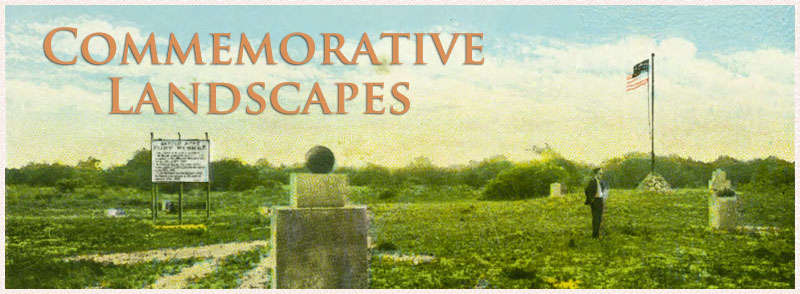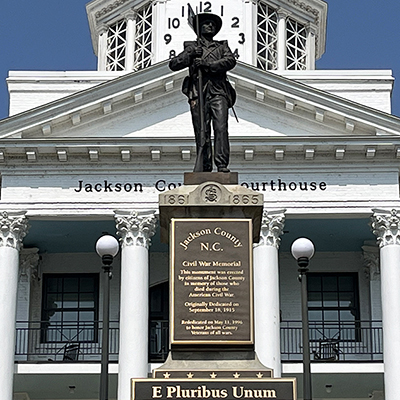
Confederate Soldiers Monument, Sylva
This monument depicts a Confederate infantryman standing with left foot slightly forward. He is holding a musket with attached bayonet, butt resting on the ground, gripping it with both hands in front of his body which would have been the parade rest pose from the Civil War era. The figure is wearing a pack back with bedroll and a canteen slung across the body. The empty bayonet scabbard hands from the belt. The copper alloy soldier stands atop a tiered stone base in front of the old courthouse building. The thick bottom tier of the monument is finished with rough stone, which gives way to a triple base of finished granite. The statue stands atop the plinth that rises above the base. The top of the plinth shows a Confederate States of America design between the start and end dates of the Civil War. The plinth front originally featured a bas-relief of a partially furled Confederate battle flag attached to a pole. That feature was covered in 2020 after Confederate memorials became the focus of civil unrest across the country. A plaque with a new inscription was added in September 2021 to permanently cover the flag. An inscription below the flag “…heroes of the Confederacy” was also covered. The original bronze tablet remains on the rear face of the plinth.
Images before 2022:
In 2020 base inscriptions were covered |
Rear view, April 2021 |
Vintage postcards: View of monument from base of courthouse steps: Postcard 1,
Postcard 2 |
As of July 2023:
Close-up view of the memorial |
Side view of the memorial |
Rear view |
Confederate memorial with the historic courthouse building |
Close shot of the statue |
Front and base inscriptions |
"To Our Valiant Fathers..." plaque |
Front view of the memorial with the courthouse building |
View of the monument from the courthouse staircase |
Mountains, city and the monument |
Far-off view of the Jackson County Courthouse and all memorials |
Jackson County Courthouse steps and memorials |
View of the W. Main Street from the courthouse staircase |
Jackson County old courthouse building and its staircase |
Plaques dedicated to the Sylva preservation and Main Street revitalization projects
Back (west), plaque: TO OUR VALIANT FATHERS: - / CHAMPIONS OF RECONCILIATION WITH / JUSTICE, OF UNION WITH MANHOOD, / OF PEACE WITH HONOR; THEY FOUGHT / WITH FAITHFULNESS, LABORED WITH / CHEERFULNESS, AND SUFFERED IN SILENCE. / TO OUR HEROIC MOTHERS: - / SPARTAN IN DEVOTION, TEUTON IN / SACRIFICE, IN PATIENCE SUPERIOR TO EITHER / AND IN MODESTY AND GRACE / MATCHLESS AMONG WOMANKIND.
Front (east), plinth: 1861 CSA 1865
Front (east), base, no longer visible, possibly removed: OUR HEROES / OF THE CONFEDERACY
Front (east), covering Confederate Battle flag, added in 2021: JACKSON COUNTY / N.C. / CIVIL WAR MEMORIAL / THIS MONUMENT WAS ERECTED / BY CITIZENS OF JACKSON COUNTY / IN MEMORY OF THOSE WHO / DIED DURING THE / AMERICAN CIVIL WAR. / ORIGINALLY DEDICATED ON / SEPTEMBER 18, 1915 / REDEDICATED ON MAY 11, 1996 / TO HONOR JACKSON COUNTY / VETERANS OF ALL WARS.
Front (east) base covering removed inscription, added in 2021: E PLURIBUS UNUM
Jackson County
September 18, 1915. Rededication: May 11, 1996
35.373780 , -83.227640
View in Geobrowse
"Illuminated Fountain at foot of Jackson County Court House, Sylva, N.C." in North Carolina Postcard Collection (P052), North Carolina Collection Photographic Archives, Wilson Library, UNC-Chapel Hill Link
"Our Confederate Monument," Jackson County Journal (Sylva, NC), August 29, 1919, (accessed January 30, 2015)
"Unveiling Monument," Jackson County Journal (Sylva, NC), August 27, 1915, (accessed January 30, 2015)
"Unveiling of the Confederate Monument," Jackson County Journal (Sylva, NC), September 24, 1915, (accessed January 30, 2015)
"Wanted," Jackson County Journal (Sylva, NC), August 27, 1915, (accessed January 30, 2015)
Butler, Douglas J. North Carolina Civil War Monuments: An Illustrated History (Jefferson, North Carolina: McFarland & Company, 2013).
Kayes, Holly. “Commissioners Vote to Keep Sylva Sam, With Some Changes,” Smokey Mountain News (Waynesville, NC), August 5, 2020, (accessed August 23, 2020) Link
Kneopp, Lilly. “EPluribus Unum,’ Jackson County Confederate Monument Updated” WUNC, September 22, 2021, (accessed July 29, 2023) Link
Kneopp, Lilly. “Sylva Rejects Jackson County Commissioners Planned ‘Sylva Sam’ Updates,” Blue Ridge Public Radio, July 25, 2021, (accessed July 29, 2023) Link
Kracher, Frank. “Town Wants County to Remove Sylva Sam,” WLOS.com, (Asheville, NC), July 27, 2020, (accessed August 23, 2020) Link
United Daughters of the Confederacy, North Carolina Division. Minutes of the Nineteenth Annual Convention of the United Daughters of the Confederacy North Carolina Division, Held at Charlotte, North Carolina, October 6, 7, 8, 1915 (Wilmington, N.C: Wilmington Stamp and Printing Company), 86, (accessed January 30, 2015) Link
United Daughters of the Confederacy, North Carolina Division. Minutes of the Twenty-Fifth Annual Convention of the United Daughters of the Confederacy North Carolina Division, Held at Winston-Salem, North Carolina, October 25, 26, 27, 1921 (Gastonia, N.C.: Brumley-Walters Printing Co.), 99-100, (accessed January 30, 2015) Link
United Daughters of the Confederacy, North Carolina Division. Minutes of the Twenty-Fourth Annual Convention of the United Daughters of the Confederacy North Carolina Division, Held at New Bern, N.C., October 13, 14, 15, 1920 (Charlotte, N.C.: Queen City Printing Company, 1920), 139, (accessed January 30, 2015) Link
“Historic Courthouse Images.” The Sylva Herald, (accessed February 10, 2015) Link
“Jackson County Confederate Monument - Sylva, NC,” Waymarking.com, (accessed January 30, 2015) Link
“Jackson County Confederate Monument, (sculpture).” Art Inventories Catalog, Smithsonian American Art Museum, SIRIS, sirismm.si.edu, (accessed January 30, 2015) Link
“Jackson County Court House, Sylva, N.C.,” in Durwood Barbour Collection of North Carolina Postcards (P077), North Carolina Collection Photographic Archives, Wilson Library, UNC-Chapel Hill Link
Yes
Bronze, granite, copper
$1400
Fifty years after the Civil War ended, the monument was unveiled with a series of grand celebrations. More than 3000 people from the town and surrounding area were in attendance. There was a parade commanded by Captain Frederick Rutledge of the Governor’s Horse Guards, a speech by General Theodore F. Davidson from Asheville, and music by First Regiment Brass Band from Asheville. The event also included children singing patriotic Southern songs and a “living flag” comprised of young women wearing red, white, and blue, as well as free dinner and special rates on transportation.
In the mid-1990s, the statue was removed, refurbished, and then rededicated on May 11, 1996.
Sylva Sam
This monument was built to honor the 164 soldiers from Jackson County who served in the Confederate Army during the Civil War, and all the citizens who helped with the war effort.
The statue was made by the W. H. Mullins Company, which was a large manufacturing company in Salem, Ohio. At least eight other statues in the state of North Carolina are known Mullins’ products, including one from 1924 in Asheboro, N.C., which is identical except for the placement of the soldier’s backpack. Six statues are parade rest models dating from from 1911 to 1925 (including one monument in Albemarle and one in Greenville).
Following the massacre of nine African Americans in a church in Charleston, South Carolina on June 17, 2015 by white supremacist Dylann Roof, Americans, especially southerners, have reflected on and argued over the historical legacy of slavery, the Civil War, the Confederacy, and white supremacy. Monuments have been a particular focus of these debates and controversies, especially after the death of a counter-protester, Heather Heyer, at a white supremacist rally in Charlottesville, Virginia in August 2017 and after President Donald Trump expressed his opposition to the removal of Confederate memorials. Despite laws in many southern states intended to prevent or impede the removal or relocation of historical monuments, protesters and local community leaders have removed or relocated controversial monuments associated with slavery, the Confederacy, and white supremacy. The pace of the removal of controversial monuments accelerated sharply in 2020, following the death of George Floyd at the hands of police in Minneapolis, Minnesota. Against the backdrop of protests against police brutality and white supremacy across the nation, local authorities in many communities in North Carolina removed and/or relocated monuments that were the focus of civil unrest.
On July 27, 2020, by a 3-2 vote the Sylva Town Commission requested that Jackson County remove and possibly relocate the statue known as “Sylva Sam.” On August 4, 2020, Jackson County Commissioners rejected that request by a 4 to 1 vote. In a compromise the commissioners did agree to modify the monument. Changes would include the Confederate flag etched into the base being covered with a plaque giving a brief history of Jackson County’s role in the Civil War. The words “Our Heroes of the Confederacy,” which appear below the flag, would be removed. The compromise did not settle the issue as members of Reconcile Sylva vowed to continue efforts to have it removed. Supporters of keeping the memorial in place also acknowledged they expected efforts to have it removed would continue. Despite the Sylva Town Commission voting against the wording for the new inscription in July 2021, Jackson County placed the new plaques on September 21, 2021.
The monument stands halfway up the steps to the old Jackson County Courthouse building, which is now the town’s public library. The steps begin at the intersection of W. Main St. and Keener St. in Sylva, NC. War Memorial Fountain and the Jackson County Veterans Memorial are located at the bottom of the staircase. The Jackson County Founding and Time Capsule marker and the Jackson County Armed Forces Memorial stand right to the left corner of the old Jackson County Courthouse building.
The monument is surrounded by stone steps and the green, landscaped grounds of the library. It overlooks the hilly downtown area to the east.
June 23, 1921 there was a ceremony during which wreaths were placed on the monument by the B. H. Cathey Chapter, United Daughters of the Confederacy.
 Know anything else about this monument that isn't mentioned here? If you have additional information on
this or any other monument in our collection fill out the form at the Contact Us link in the footer. Thank you.
Know anything else about this monument that isn't mentioned here? If you have additional information on
this or any other monument in our collection fill out the form at the Contact Us link in the footer. Thank you.

